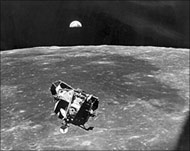Most Americans oppose Bush space mission
More than three-fifths of North Americans oppose US President George Bush’s proposal to return to the moon and eventually put a human on Mars, according to a poll released on Sunday.

His plan to spend billions of dollars for manned missions to the moon and eventually to Mars drew opposition from 61% of the 1003 adults surveyed on 14-15 January.
Bush has called for a new space vessel capable of travelling to the moon as early as 2015. He would give the US space agency NASA an additional budget of $15.4 billion.
Even among members of Bush’s own Republican party, 48% opposed the plan against the 42% who supported it.
Some 40% of those questioned in the Time/CNN poll said they would rather improve education.
Only seven percent said they would enlarge the military.
Possible battleground?
Some observers believe that Bush’s plan to expand the exploration of space parallels US efforts to control the heavens for military, economic and strategic gain.
Under a 1996 space policy adopted by then President Bill Clinton that remains in effect, Washington is committed to the exploration and use of outer spaces “by all nations for peaceful purposes for the benefit of all humanity”.
“Consistent with treaty obligations, the United States will develop, operate and maintain space control capabilities to ensure freedom of action in space, and if directed, deny such freedom of action to adversaries,” according to the policy.
 |
|
Bush has called for a permanent |
No country depends on space and satellites as its eyes and ears more than the United States, which accounted for as much as 95% of global military space spending in 1999, according to the French space agency CNES.
“Yet the threat to the US and its allies in and from space does not command the attention it merits from the departments and agencies of the US government charged with national security responsibilities,” reported a congressionally chartered task force.
The task force was headed by US Defence Secretary Donald Rumsfeld and made the statement 10 days before Bush and he took office in 2001.
Making it reality
The capabilities to conduct space warfare would move out of the realm of science fiction and into reality over the next 20 years or so, said Theresa Hitchens of the private Centre for Defence Information.
“At the end of the day it will be political choices by governments, not technology, that determines if the nearly 50-year taboo against arming the heavens remains in place,” she concluded in a recent study.
|
“I think the new initiative is driven by a desire to beat the Chinese to the moon” |
Outlining his election-year vision for space exploration last week, Bush called for a permanent base on the moon by 2020 as a launch pad for piloted missions to Mars and beyond.
One unspoken motivation may have been China’s milestone launch in October of its first piloted spaceflight in earth orbit and its announced plan to go to the moon.
“I think the new initiative is driven by a desire to beat the Chinese to the moon,” said John Pike, director of GlobalSecurity.org, a defence and space policy research group.
Among companies that could cash in on Bush’s space plans are Lockheed Martin Corp., Boeing Co. and Northrop Grumman Corp., which do big business with the National Aeronautics and Space Administration along with the Pentagon.
Controlling prices
Scientists say the moon is a source of potentially unlimited energy in the form of the helium 3 isotope-a new perfect fuel source.
“And if we could get a monopoly on that, we wouldn’t have to worry about the Saudis and we could basically tell everybody what the price of energy was going to be,” said Pike.
The moon’s helium 3 may have a cash value of $4 billion a tonne in terms of its equivalent in oil, said Gerald Kulcinski of the Fusion Technology Institute.
Among other things, the Pentagon expects to spend at least $50 billion over the next five years to develop and field a multi-layered shield against incoming missiles that could deliver nuclear, biological or chemical weapons.